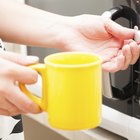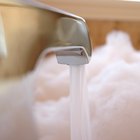
Pouring boiling water into a glass container is a quick way to shatter it, but the tempered glass used in teapots is different. It's specially strengthened to withstand the stresses caused by sudden temperature changes, either by chemical or physical means. Although this tempered glass is unusually durable, it's still prudent to exercise some care when using it.
Why Glass Shatters
Glass is a brittle material. It's relatively strong for its weight, but it breaks easily when subjected to stress. Heat stress causes much the same effect because, like many other materials, glass expands and contracts as it heats and cools. If cool glass suddenly has hot liquid poured in, or if hot glass is set down on a cold surface, the expanding hot side and contracting cold side can apply enough force to make the glass break.
And Why Sometimes it Doesn't
Most kitchens contain a wide range of heat-resistant glass products, from cups and teapots to casserole dishes, so clearly it's possible to work around that limitation. One way is to make glass that's innately resistant to thermal shock. This is done by adding boron oxide to the glass when it's manufactured. The boron produces an extra-tough glass called borosilicate, which can withstand about three times as much heat stress as ordinary glass. It's used in laboratory glassware and industrial applications, as well as in bakeware and cookware for the home.
Keeping Your Temper
A second approach to heat resistance manipulates the physical characteristics of glass through a process called tempering. It's done by subjecting orrdinary glass, or soda-lime glass as it's sometimes called, to a sudden cold blast of air while it's still hot from the furnace. This creates thermal stress, which is preserved as the glass hardens. This essentially counters any thermal stress the glass is exposed to during normal use, making it resistant to shattering. It has the additional benefit of strengthening the glass against damage from physical stress, which is also useful in the home kitchen.
Using Your Glass Teapot
Whether your teapot is made of borosilicate or the cheaper heat-tempered form of glass, it's important to remember that it is heat-resistant rather than heatproof. If the ambient temperature in your kitchen is low, swish warm water around the teapot to gently warm it before you use it. That's a good technique anyway, because your tea will steep more effectively if the water doesn't lose heat to the teapot. Once you've poured in the boiling water, rest your teapot on a trivet or kitchen towel rather than on the cold countertop. These simple precautions can help your teapot survive through many years of safe use.
Related Articles

Can You Use a Glass Pan to Cook a Roast?

Example of Passive Solar Energy

What are Goblets Used For?

Can I Make a Cake Mix in a Ceramic Dish?

What Types of Crystals Are Used in ...

Can You Microwave Ceramic Mugs?
How to Lower Cooking Times & ...

Can You Cook Frozen Dinners in Glass?

Uses of Thermal Insulators

What Is Better for Cookware: Glass, ...

Cooking With Glass Vs. Ceramic

Glass Scalp Rake for Hair Growth

Why Heat Does Not Transfer Through a ...

Is Corning Cookware Safe?

How to Keep Bathwater Hot

The Disadvantages of Passive Solar ...

Titanium Vs. Tourmaline Flat Irons

What Is Magnalite?

Does a Chilled Champagne Bottle Need to ...

Heating Foods in Plastic & BPA
References
- On Food and Cooking: The Science and Lore of the Kitchen; Harold McGee
- Corning Museum of Glass: Finding the Right Recipe -- Borosilicate Glass
- Breakglass.org: How Is Glass Made? Read about Toughened Glass Manufacture
- U.S. Department of Energy Ask a Scientist!: Thermal Stress and Glass
Writer Bio
Fred Decker is a trained chef and prolific freelance writer. In previous careers, he sold insurance and mutual funds, and was a longtime retailer. He was educated at Memorial University of Newfoundland and the Northern Alberta Institute of Technology. His articles have appeared on numerous home and garden sites including GoneOutdoors, TheNest and eHow.
Photo Credits
Creatas/Creatas/Getty Images